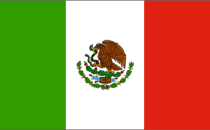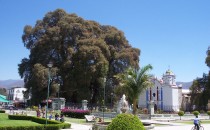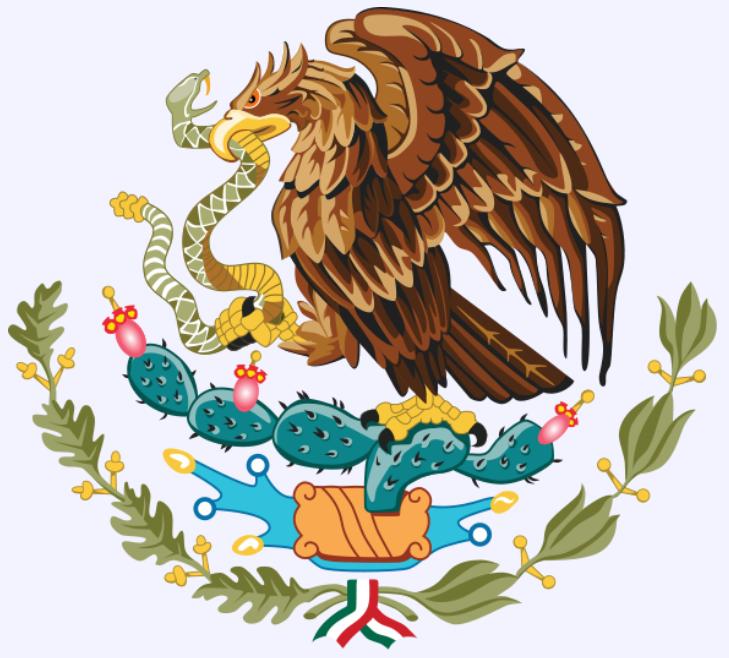Index
1. National Symbols
Official country name: Estados Unidos Méxicanos
 Mexico’s national flag was created in 1821, after the victory of the independence movement. Green stands for the independence movement, white for the purity of the Catholic faith and red for the blood shed in the struggle for independence. The Flag Day is celebrated on 24 February.
Mexico’s national flag was created in 1821, after the victory of the independence movement. Green stands for the independence movement, white for the purity of the Catholic faith and red for the blood shed in the struggle for independence. The Flag Day is celebrated on 24 February.
 Mexico’s national tree is the cypress. The most spectacular specimen of this genus is the gigantic 2000 year old tree of Tule in the village of the same name near Oaxaca. (Photo: © Gengiskanhg)
Mexico’s national tree is the cypress. The most spectacular specimen of this genus is the gigantic 2000 year old tree of Tule in the village of the same name near Oaxaca. (Photo: © Gengiskanhg)
 Mexico’s national flower is the dahlia. Its hollow stem already served the Aztec hunters as a water reservoir. In fact, acocotli, the Aztec name of the dahlia, means water pipe. (Photo: Andreas Volkmer)
Mexico’s national flower is the dahlia. Its hollow stem already served the Aztec hunters as a water reservoir. In fact, acocotli, the Aztec name of the dahlia, means water pipe. (Photo: Andreas Volkmer)
 Mexico’s national coat of arms reflects the Aztec founding myth. Legend has it that the gods, as the Aztecs migrated south, meant to build their capital where they would see an eagle sitting on a cactus eating a snake. Finally, the Aztecs saw that mythical eagle, on a swampy island in the middle of a lake, at the place where the huge Zócalo Mexico City stretches out today.
Mexico’s national coat of arms reflects the Aztec founding myth. Legend has it that the gods, as the Aztecs migrated south, meant to build their capital where they would see an eagle sitting on a cactus eating a snake. Finally, the Aztecs saw that mythical eagle, on a swampy island in the middle of a lake, at the place where the huge Zócalo Mexico City stretches out today.
back to top
2. State and Society
| Form of state and government | Federal Republic |
| President and Head of Government | Andrés Manuel López Obrador (elected 1 July 2018, inaugurated 1 December 2018) |
| next elections | 2024 |
| political system | Two-chamber system of the National Congress, consisting of a Senate with 128 seats (elected for 6 years) and a Chamber of Deputies with 500 seats (elected for 3 years). |
| political parties | “Partido Acción Nacional” (PAN), middle-class, Christian-democratic, strong in the north and urban centers; “Partido Revolucionario Institucional” (PRI), former state party with left-wing populist influence; “Partido de la Revolución Democrática” (PRD), left-social democratic, founded 1989 by Cuauhtémoc Cárdenas, the first directly elected mayor of the federal district Mexico City; “Partido Verde Ecologista de México” (PVEM), Green-Ecological Party |
| right to vote | 18 years and older (compulsory voting is not enforced) |
| capital | Mexico City, 22 million inhabitants (estimated) |
| inhabitants | 125,9 million (July 2018, estimated by the CIA) |
| ethnic composition | Mestizos 60%; Indígenas 30%; “White” of European origin 9%, other 1.0% |
| religion | approx. 89% (nominal) Roman Catholic, 6% Protestant (especially churches of North American origin), others 5% |
back to top
3. Geography
| area | 1.958.201 km2 |
| highest peak | Pico der Orizaba 5700 m |
| lowest point | Laguna Salada -10 m |
| geographical location | Between 15° and 32° northern latitude and 87° and 117° western longitude. Geographically, Mexico belongs to North America. It borders the USA to the north, the Gulf of Mexico to the northeast and east, the Pacific to the west and Guatemala and Belize to the south and southeast. The Yucatán Peninsula borders the Caribbean Sea to the east. |
| terrain | Two high, jagged mountain cordilleras cross Mexico from north to south, between them lies a distinctive high plateau, the Meseta Central, whose height varies between 1,500 and 3,000 meters. Flat coastal plains at the Atlantic and Pacific as well as extensive deserts in the north complete the landforms. |
| climate | Mexico’s climate ranges from desert climates in the north to tropical climates in the south. Temperatures vary with the respective altitude. |
| flora and fauna | The world’s greatest diversity of ecosystems and habitats corresponds to the geographical and climatic range. It ranges from steppe vegetation to tropical rainforests, from mangrove swamps to cactus deserts. Tree species include hardwoods, coconut palms, rubber trees, almond, fig and olive trees, as well as oaks, pines and firs. Mexico’s animal world is also extremely diverse: wolves, coyotes, ocelots, jaguars, pumas, coatis, peccaries and monkeys, the most species-rich reptile fauna in the world, a species- and individual-rich bird world, as well as 14 percent of all fish species in the world, plus several seal and whale species. |
| natural risks | Tsunamis on the Pacific coast, volcanic eruptions and earthquakes in the interior and south, as well as hurricanes on all coasts. |
| natural resources | petrolium, silver, copper, gold, lead, zinc, natural gas, timber |
back to top
4. Economy
| Overview | Mexico’s economy has both state-of-the-art and obsolete elements in all sectors. In recent years, ports, railways, telecommunications, electricity and gas supply have been privatized, and Mexico’s second-largest bank (Banamex) has also been part of Citigroup since 2001. Since the Free Trade Agreement with the USA and Canada came into effect, the volume of trade with both countries has tripled. The economic growth of the first free trade years was followed by years of stagnation, depending on developments in the USA. Income distribution remains highly uneven. |
| Population below the poverty line |
47 % (2014, source: CIA World Factbook) |
| per capita income | 19.900 USD (nach Kaufkraft-Parität, 2017) |
| distribution of income | In 2014, the poorest 10% of the population accounted for only 2 % of total consumption in the country, while the richest 10% accounted for 40 % of total consumption. |
| inflation rate | 6 % (2017, estimated, source: CIA World Factbook) |
| unemployment rate | 3,4 % (2017, source: IWF) |
| gross domestic product (GDP) |
1,142 Billions USD (2017), source: IWF |
| GDP by sector | services 62.4% agriculture 3.5% industry 34.1% (2017, estimated) |
back to top
5. Environment
| environmental issues | Lack of landfills for hazardous waste, rural exodus and the associated problems in the urban peripheral zones. Lack of freshwater resources in the north, inland and southwest, poor quality of drinking water, and industrial water pollution in the metropolitan areas around the capital and the industrial cities along the border with the US. These cities face also serious air pollution. Deforestation and the associated large-scale soil erosion. Loss of quality and leaching of agricultural land, desertification. In the high valley of Mexico, the dwindling groundwater reserves cause a lowering of the once swampy subsoil. The lack of clean drinking water and increasing deforestation are considered national security concerns. |
| International environmental agreements | signed, but not ratified: Convention on Biodiversity Climate Framework Convention Kyoto Protocol UN Convention to Combat Desertification Convention on International Trade in Endangered Species (CITES) Basel Convention on the Transboundary Transport of Hazardous Wastes United Nations Convention on the Law of the Sea Partial Test Ban Treaty (PTBT) Convention on the Prevention of Marine Pollution by Dumping of Wastes and Other Matter 1972 Additional Protocol of 1978 to the Convention on the Prevention of Marine Pollution by Dumping of Wastes and Other Matter (MARPOL) Marine Life Conservation Ozone Layer ProtectionInternational Convention for the Regulation of Whaling Convention on Wetlands of International Importance especially as Waterfowl Habitat(Ramsar Convention) |
back to top
6. Human Rights
| human rights currently | The protection of human rights is not guaranteed in Mexico. During his visit to Mexico in October 2015, the UN High Commissioner for Human Rights, Zeid Rada Al Hussein, attested that the number of people who had been forcibly killed for a country that was not at war was enormous. 151,233 people were murdered between December 2006 and August 2015, including thousands of migrants. At least 26,000 people have disappeared. Thousands of women and children have been victims of sexual abuse and murder. Official statistics show that 98 percent of these crimes are unsolved, the majority of cases not even investigated. Organised crime is responsible for only some of these crimes. A substantial part of the crimes are committed by local, regional and federal police, or even the military, often under the guise of the war on drugs proclaimed by President Calderón in 2006. The conclusion of the “Institute for Economics and Peace” in its Mexico Peace Index 2015 is somewhat more positive: According to the index, the number of homicides has fallen by 30% in the last two years, with the states considered to be at least peaceful making the greatest progress. The differences between the 32 states remain significant, with Hidalgo being the most peaceful, followed by Yucatán, Querétaro, Campeche and Tlaxcala. The least peaceful state is Guerrero, followed by Morelos, Sinaloa, Michoacán and Guanajuato. For both sources of crime, the lack of efficiency of the judicial system and the low number of convictions are the main obstacles to positive, more peaceful development. |
back to top
